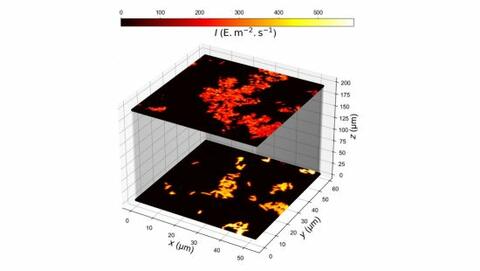
Fluorescence for measuring light intensity
Absolute light intensity measurements are indispensable in many scientific and engineering fields. The team from the Laboratoire Pasteur studied two protocols that exploit fluorescence to allow simple, rapid and inexpensive measurement of light intensity over wide ranges of wavelengths and intensities, providing information on the spatial distribution, including in the depth of the samples.
Absolute measurements of light intensity over a wide range of wavelengths and light intensities are essential in many fields (bio-imaging, optogenetics, photoproduction of molecules and materials, design of medical protocols, photocatalysis, etc.). In particular, they enable a rational choice to be made of parameters such as the duration of light application, in order to deliver the right number of photons to a sample. They also enable a fair comparison of the results obtained by different research groups, thereby guaranteeing reproducibility.
The protocols currently available to biologists, chemists, engineers and physicists require specific equipment and expertise. They also suffer from limitations in their scope. There was therefore a need for simple, short protocols for robustly accessing this measurement, a conclusion that resonates with the needs raised by the QUAREP-LiMi community for calibrating illumination in optical instruments.
This article responds to this need by reporting two protocols that exploit fluorescence to enable simple, rapid and inexpensive measurement of light intensity over wide ranges of wavelengths and intensities, providing information on spatial distribution, including in the depth of samples. The first protocol is based on species whose fluorescence intensity decreases/increases mono-exponentially when constant light is applied. The second protocol uses a photochemically inert fluorophore with broad absorption to recalculate light intensity from one wavelength to another.
To demonstrate their usefulness, these protocols have been applied to quantitatively characterize the spatial light distribution of various fluorescence imaging systems and to calibrate the illumination of commercially available instruments and light sources.
Reference
Lahlou, A., Tehrani, H. S., Coghill, I., Shpinov, Y., Mandal, M., Plamont, M., Aujard, I., Niu, Y., Nedbal, L., Lazár, D., Mahou, P., Supatto, W., Beaurepaire, E., Eisenmann, I., Desprat, N., Croquette, V., Jeanneret, R., Saux, T. L., & Jullien, L. (2023). Fluorescence to measure light intensity. Nature Methods. https://doi.org/10.1038/s41592-023-02063-y
Contact
Ludovic Jullien
Professeur
Laboratoire PASTEUR (UMR 8640)
Tutelles : CNRS / ENS / Sorbonne Université
